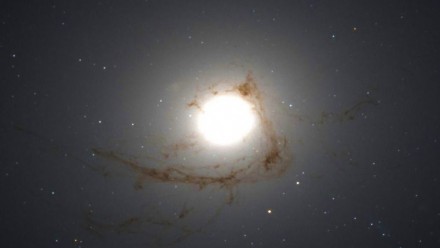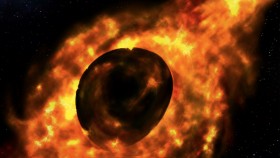Understanding a lumpy universe
ANU ScienceWise Magazine - Summer 2011
If you look into the sky on a clear, dark night, you’ll probably notice the Milky Way, a faint, broad ribbon of light crossing from one horizon to the other. What you’re actually seeing is an edge-on view through our own galaxy which contains roughly 300 billion stars, one of which is our Sun. If you could step well outside the Milky Way, you’d see that it’s a barred spiral galaxy looking something like the picture below. However you’d probably also notice that the Milky Way is not alone. Our galaxy and about 40 others form what’s known as the Local Group. If you step back even further, you’d see that the Local Group is one of many groups and clusters of galaxies, and that they’re made up of galaxies of all different shapes and sizes, from beautiful spirals like our Milky Way, to faint, oddly-shaped dwarf galaxies, and the round, fuzzy balls of stars that are known as elliptical galaxies. How the galaxies in the universe formed as they did is a central question in astronomy.
A PhD student at the ANU Research School of Astronomy and Astrophysics, Catherine Farage, is studying massive ellipticals in galaxy clusters, to look for clues that could help to explain the mechanisms behind the formation of large galaxies.
“At the centre of most galaxy clusters there are usually one or two giant elliptical galaxies,” Catherine says, “These are the brightest and most massive galaxies in the nearby universe and are located in very busy and active environments.”
When these central giant ellipticals are observed with a sufficiently powerful telescope, we see that many have nebulous filaments and streams of gas associated with them. “Understanding the nature of these filaments will shed light on how the galaxy itself is interacting with its surroundings - with other galaxies and the material that makes up the cluster. Interactions like that are thought to play a very important role in how all galaxies grow and evolve.” Catherine explains, “But we can’t do that just by looking at images of galaxies, we also need information about the motion of the material within them.”
To gather such information astronomers use spectroscopy. By looking at how the narrow emission and absorption lines in the spectrum of a particular star or patch of interstellar gas are Doppler-shifted by movement, it’s possible to calculate its velocity. It would be possible to do this across a whole galaxy by taking one spectrum after another at many different points and building this information up into a map, but this could take a very long time and isn’t an efficient use of telescope resources. So astronomers generally use what’s known as an Integral Field Spectrograph (IFS) to record the spectra of all parts of a region of space simultaneously.
To do this across a relatively wide area of the sky to cover a large galaxy is a challenging task for instrument designers. However, the ANU Research School of Astronomy and Astrophysics have recently completed a wide field IFS and installed it on the 2.3 metre telescope at Siding Spring that Catherine has been using for her research.
“In most clusters it’s thought that these nebulous filaments may be the result of either interstellar material from the cluster falling towards the centre where the minimum of the gravitational potential well is, or of material in the galaxy being blown out by the activity of the black hole in the galaxy centre,” Catherine says, “But in the case of one particular galaxy NGC 4696, our initial results suggest that the filaments are actually related to a recent merger of an external galaxy and the massive central elliptical of the Centaurus cluster.”
One of the tricky things about studying motions in the gas structures, like these filaments, around a galaxy is knowing whether you’re looking at outward motion from a filament behind the galaxy or inward motion from one in front. Fortunately in this case the dust lanes seen in front of the galaxy are clearly associated with the filaments so the astronomers can be pretty sure that the material is in front of the galaxy and is falling into it.
Catherine became interested in astronomy through one of her science teachers at school and having completed a Bachelors degree in Queensland, transferred to ANU to do her Honours year in Astronomy. “One of my favourite aspects of this project is using the 2.3 metre telescope at Siding Spring. It’s a lot of fun to have such a large telescope at your disposal and get to operate all aspects of it yourself.”












